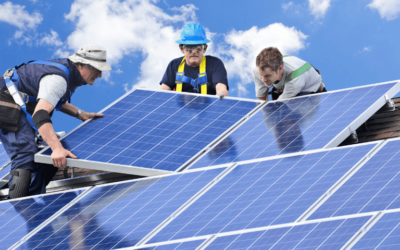Across the United States, K-12 schools are increasingly embracing solar energy as a way to power their facilities, save money, and educate future generations about sustainability. Solar energy for schools offers wide-ranging benefits for students, staff, and the environment, making it an investment in both education and a cleaner future.
One of the most significant advantages of using renewable energy in schools is cost savings. By generating their own power through solar panels, schools can significantly reduce their utility expenses, allowing more funding to be directed toward educational programs, staff development, and student resources. According to Brighter Future: A Study on Solar in U.S. Schools, published in 2022, approximately 8,400 schools nationwide have adopted solar, contributing over 1,600 MW of solar capacity. This shift not only enhances budgets but also serves as a tangible lesson in real-world energy management for students.
For students, the integration of solar energy goes beyond operational savings. Many schools that install solar panels also incorporate renewable energy topics into their curriculum, offering students hands-on learning opportunities in science, technology, engineering, and mathematics (STEM). Exposure to real-time solar production data, discussions about energy independence, and projects focused on environmental stewardship can foster a deeper understanding of global energy challenges. These educational opportunities help inspire the next generation of engineers, scientists, and environmental leaders.
Staff members also benefit from schools powered by renewable energy. Lower operational costs can translate into better-resourced classrooms and professional development opportunities. Furthermore, schools that focus on sustainability often experience an increase in community engagement and pride, enhancing the overall morale of both teachers and support staff.
The environmental impact is equally important. By switching to solar, schools contribute to a substantial reduction in carbon emissions. This supports global efforts to combat climate change while directly improving local air quality — a particularly important factor for young children, who are more vulnerable to pollution-related health issues.
Minnesota provides a great example of solar adoption in schools. With more than 23 MW of solar installed across nearly 190 schools, Minnesota ranks 13th in installed solar capacity and 11th in total number of solar schools. Much of this progress is thanks to targeted programs such as the Solar for Schools grant program, established by the Minnesota State Legislature in 2021. Administered by the Minnesota Department of Commerce Division of Energy Resources, the program supports the installation of solar energy systems while encouraging schools to integrate renewable energy education into their curriculum. Since its launch in 2022, 92 Minnesota schools have been awarded grants, with more expected as the final funding rounds are completed in 2024.
Schools interested in pursuing solar panel installations in Minnesota can also explore commercial rebates currently available in 2025. Two noteworthy programs include:
- Solar for Schools Program (Minnesota Department of Commerce): This ongoing initiative provides direct grants to K-12 public schools, charter schools, and state colleges to offset the costs of solar energy system installations. Applications for the 2025 cycle are open and available through the Minnesota Department of Commerce website.
- Xcel Energy Solar*Rewards for Schools: Available to qualifying schools within Xcel Energy service areas, this program offers production-based incentives to help cover the cost of solar systems. Schools can apply in 2025 to receive rebates based on the amount of solar energy their system produces over time.
Solar energy for schools is a powerful tool to support financial stability, educational advancement, and environmental responsibility. With available solar panel rebates in Minnesota and strong community support, the path toward a renewable energy future for schools has never been clearer.
Click here to read the full article, originally published by the Minnesota Department of Commerce.






0 Comments